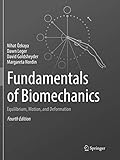Fundamentals of Biomechanics [electronic resource] : Equilibrium, Motion, and Deformation / by Nihat Özkaya, Dawn Leger, David Goldsheyder, Margareta Nordin.
Material type: TextPublisher: Cham : Springer International Publishing : Imprint: Springer, 2017Edition: 4th edDescription: xv;454 pContent type:
TextPublisher: Cham : Springer International Publishing : Imprint: Springer, 2017Edition: 4th edDescription: xv;454 pContent type: - text
- computer
- online resource
- 9783319831251
- 612 23
- QP34-38
| Item type | Current library | Collection | Call number | Status | Barcode | |
|---|---|---|---|---|---|---|
| Book 1 (Do Not Chose) | Air University Central Library Islamabad Biomedical Engineering | Location Ground Floor Biomedical Engineering: Shelve No 31-35 | 571.43 FUN (Browse shelf(Opens below)) | Available | P5499 |
Browsing Air University Central Library Islamabad shelves, Shelving location: Biomedical Engineering , Collection: Location Ground Floor Biomedical Engineering: Shelve No 31-35 Close shelf browser (Hides shelf browser)

|

|

|

|

|

|
No cover image available | ||
| 570.76 JON-C Cambridge International AS/A Level Biology Revision Guide 2nd edition | 571.01518 COB Introduction to modeling in physiology and medicine | 571.4 CLA Introductory biophysics | 571.43 FUN Fundamentals of Biomechanics | 571.455 PRA-I Introduction to Biophotons' | 571.640113 DAT An introduction to modeling of transport processes : | 572 HOL Principles of physical biochemistry |
Preface -- 1. Introduction -- 2. Force Vector -- 3. Moment And Torque Vectors -- 4. Statics: Systems in Equilibrium -- 5. Applications of Statics to Biomechanics -- 6. Introduction to Dynamics -- 7. Linear Kinematics -- 8. Linear Kinetics -- 9. Angular Kinematics -- 10. Angular Kinetics -- 11. Impulse and Momentum -- 12. Introduction to Deformable Body Mechanics -- 13. Stress & Strain -- 14. Multiaxial Deformations & Stress Analyses -- 15. Mechanical Properties of Biological Tissues -- Appendix A. Plane Geometry -- Appendix B. Vector Algebra -- Appendix C. Calculus -- Index.
License restrictions may limit access.
This textbook integrates the classic fields of mechanics—statics, dynamics, and strength of materials—using examples from biology and medicine. The book is excellent for teaching either undergraduates in biomedical engineering programs or health care professionals studying biomechanics at the graduate level. Extensively revised from a successful third edition, Fundamentals of Biomechanics features a wealth of clear illustrations, numerous worked examples, and many problem sets. The book provides the quantitative perspective missing from more descriptive texts, without requiring an advanced background in mathematics. It will be welcomed for use in courses such as biomechanics and orthopedics, rehabilitation and industrial engineering, and occupational or sports medicine. This book: Introduces the fundamental concepts, principles, and methods that must be understood to begin the study of biomechanics Reinforces basic principles of biomechanics with repetitive exercises in class and homework assignments given throughout the textbook Includes over 100 new problem sets with solutions and illustrations.
There are no comments on this title.

